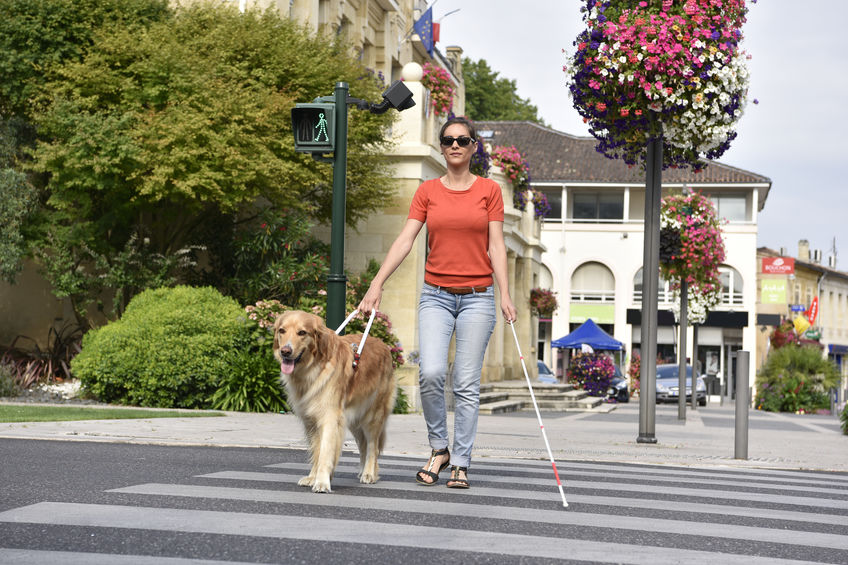Assisting Someone Who
Has a Disability

No one would invite a physical or mental condition that is limiting or disabling. But life happens, and not always as we would imagine for ourselves or others.
We all sympathize with people who have an impairment or disability. However, there are times, even without knowing it, that we express sympathy or compassion to someone in a condescending – perhaps even rude – manner.
Remaining mindful and aware can help prevent this approach. Consider if you were to be on the other side of you. The etiquette questions in this situation would be: “What shouldn’t I say?” and “When is helping rude or polite?”
Speaking of Disabilities and Impairments
When communicating about someone who experiences a disabling condition, the first rule is to always place the person first as the subject of a sentence. This helps to separate the person from the condition.
- “Mary has a hearing loss and is non-verbal,” instead of saying “Mary is a deaf-mute.”
- “Sally has epilepsy,” instead of saying “Sally is an epileptic.”
In each of the appropriate descriptions, Mary and Sally are people. They just happen to be people who have physical conditions that may call for assistance in certain situations.
Addressing Someone with a Disability
When speaking to someone who happens to have a disability or impairment, address that person properly – regardless. Speaking in an adult tone of voice is required. Baby talk or talking loudly is rude.
- Use respectful terminology in your conversations. A person who cannot speak or hear is “without speech and hearing,” but is not “deaf and dumb.”
- A person who is in a wheelchair is not “wheel chair bound” or “wheel chair confined.” This language implies that the person is less than able.
- A person who does not have a disability is “non-disabled,” rather than “healthy” or “normal.”
Some things to avoid:
- Never use the descriptor words “crippled” or “lame,” “deaf,” “invalid,” “mute,” “retarded,” “nuts,” or “handicapped.”
- Terms like “afflicted with,” “suffering from,” or “victimized by,” connote that a person is less capable.
- Do not patronize by applauding a person’s character. “You are brave and strong,” as a conversation starter is a no-go. Rather, learn about the talents, interests, accomplishments, and the work of the person – just as you would with anyone else.
- Do not make comments about how a person appears. “You look so very good today. You don’t let unfortunate things like this get you down,” is far worse than awkward.
- Do not yell or falsely intonate your voice.
When meeting and greeting someone with a disability, follow the same rules as you do when meeting anyone else.
- Offer your hand in greeting. If a person is non-sighted, speak what you are doing.
“Hello Mr. Sparks, I’m here right in front, and I’m offering you my hand.” - Establish eye contact during the handshake. If a person is without speech, he/she may have a person who is signing. Look at the person you are introducing yourself to—not at the translator.
- Follow the rules of introductions and use the name the person wishes to be called. As in any other introduction, reference the person by his given last name until you are invited to be on a first-name basis.
- Do not touch another person when you greet them. Handshakes are appropriate. If the person is in a wheel chair, treat the chair as his/her personal space. Do not touch it or lean on it.
An Offer to Assist
As a show of respect, many of us are willing to offer help to someone who appears to need assistance.
However, in cases when someone has a physical condition, we don’t want to offend and can easily get hung up on the fear of being rude.
- First of all, relax. You don't want to incapacitate yourself with fret or worry about not getting it right. We make mistakes every day and getting bent out of shape with small “goofs,” such as saying to a person who is non-sighted, “Mary, don’t you see what I’m talking about?” is over-thinking the situation. No one expects perfection. Just put yourself in the other person’s place and imagine how you would like to be treated.
- Respect the personal space and property of the person. Don’t move a wheel chair, walker, or crutches without the person asking you.
- Always ask before helping!
- When help is accepted, how you might give assistance by saying, “Ms. Williams, as I move you forward, is there anything I should avoid?” or "How is the best way for me to help?” A person who has a visual impairment may instruct you on how she wishes to be guided, and where she wishes to touch your arm. She will teach you how to be a courteous helper.
- If you are hosting an event, be anticipatory. Make sure each person’s needs have been considered. Just as you avoid serving peanuts to a person who has an allergy, asking ahead of time for specific needs can be easily worded in the invitation or with a phone call. For example, a person who doesn’t see or who has a physical condition that requires monitoring may bring a service dog, but it won’t be appropriate for other guests to pet or play with the dog.
Showing consideration and respect is the primary point of assisting someone who may need your help. An act of sympathy or compassion is appropriate, but not when it comes across as pity.
Just because someone is physically different than you, doesn’t make them “less than,” inferior, or even “disabled.” It simply makes them not you.














